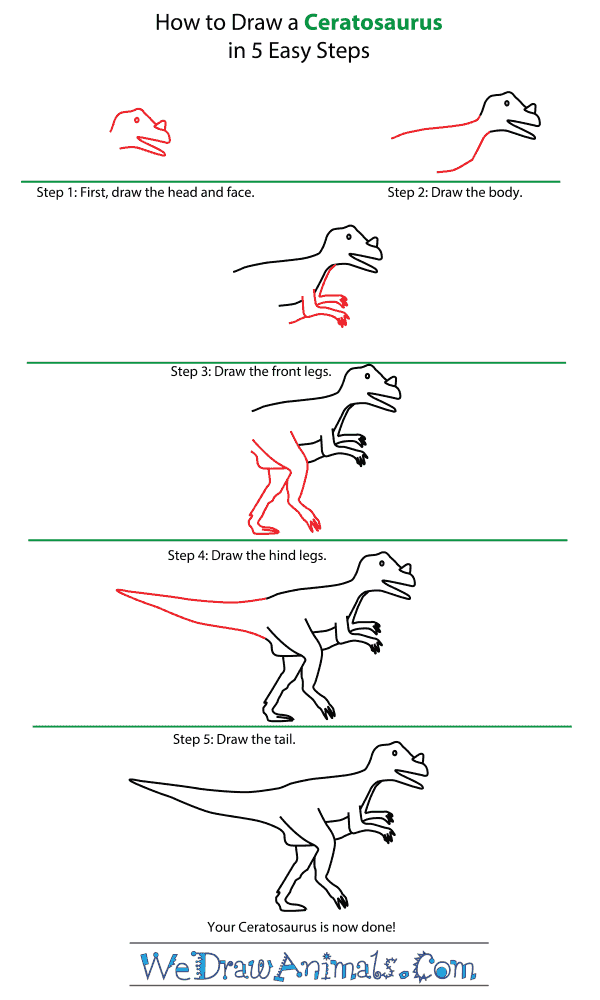In this quick tutorial you'll learn how to draw a Ceratosaurus in 5 easy steps - great for kids and novice artists.
The images above represent how your finished drawing is going to look and the steps involved.
Below are the individual steps - you can click on each one for a High Resolution printable PDF version.
At the bottom you can read some interesting facts about the Ceratosaurus.
Make sure you also check out any of the hundreds of drawing tutorials grouped by category.
How to Draw a Ceratosaurus - Step-by-Step Tutorial
Step 1: First, draw the head and face, almost like a crocodile’s: long, flat jaws, with a small crest where the eyes will be. The famous horn of the ceratosaurus is on the end of its snout above its nose. Don’t forget a circle for the eye.
Step 2: Draw the body with a long sloping line that will go from the back of the head all the way down to the start of the tail. Then draw a more angled line to show the bottom of its neck, chest and underside.
Step 3: Draw the front legs. Like in many therapods, these were small but very powerful. Draw them bent at an angle, with narrow arms and small claws ready to catch prey. Another curved line below the arms will show the pattern of the chest of the dinosaur.
Step 4: Draw the hind legs, with a series of curved lines, bending for the large thighs, knees, shins, and ankles. Put a V-shaped line behind the legs where the body meets the tail. Show one leg raised as if the ceratosaurus is running. The feet were large and flat with sharp claws.
Step 5: Draw the tail, thick and curving slightly for balance behind the dinosaur, eventually ending in a narrow point like a whip.
Interesting Facts about the CERATOSAURUS
The Ceratosaurus is a member of the dinosaur group and the scientific term for them is C. nasicornis. Their Greek name “cerato-saurus” means “horned-lizard” in English which refers to the pointed blade on its nose. The Latin term “nasicornis” means “nose-horn” in English and refers to its sharp facial feature. It also had bony ridges along the spine and had teeth shaped like blades. This predator with two legs lived in North America.
Did you know?
- The animal was first documented in 1884.
- They were up to about 22 feet long.
- This creature weighed up to over 2,000 pounds.
- They were up to over 8 feet tall.
- This species was featured in movies: Brute Force (1914), Fantasia (1940), The Animal World (1956), One Million Years B.C. (1966), The Land That Time Forgot (1975), The People That Time Forgot (1977), Jurassic Park III (2001), and a few television episodes.
here were small horns above the eyes, strong but short arms, and a skeleton with attributes like a bird. The social species was smaller than many of its relatives, but much more flexible, and had a tail like a crocodile. They hunted aquatic prey, but also attacked larger predators.






